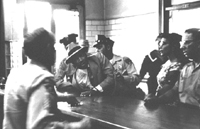We Shall Overcome: Photographs from the American Civil Rights Era
April 13 - June 6, 2004

During America's civil rights era, the fight for equal rights took many forms, including boycotts, sit-ins and marches. Photographers contributed to the movement by relaying the struggle to every corner of the nation. We Shall Overcome, comprised of 80 black and white photographs, explores the role of several prominent American photographers in documenting the era from 1954 to 1968.
The striking photographs in the exhibition are juxtaposed with the words of James Baldwin, Fannie Lou Hamer, Malcolm X, Martin Luther King, Jr. and other movement participants. These quotations provide viewers with an opportunity to examine the civil rights movement through the experiences of those directly involved with the struggle.
We Shall Overcome was developed by the Smithsonian Institution Traveling Exhibition Services (SITES), and curated by Robert Phelan, an art historian, museum curator, and former director of CREED Photos (a database project for civil rights). Following its showing at the Kuhn Library Gallery, the exhibition will continue to tour through 2004. Works in We Shall Overcome are by some of America's most thoughtful and gifted photographers, including for LIFE magazine photographers Gordon Parks and Charles Moore; Magnum photographers Bob Adelman and Leonard Freed; then-staff photographer for the Nation of Islam, Robert Sengstacke; and Black Star photographers Matt Heron and Bob Fitch. Drawn from the personal collections of the artists, these works bring the viewer into the presence of the people and events of the American civil rights movement of the 1960s. The images reflect both the power and beauty of the photographic medium when used as a tool for social change.
Photographers in We Shall Overcome captured various aspects of the civil rights movement. Leonard Freed's images represent his perceptions of racial conflict in America at the time of his return to the United States after several years abroad. Bob Adelman's photographs document voter registration activities in the Deep South. Matt Heron's pictures consider direct action by the young in the movement. Bob Fitch's work chronicles grassroots organizing, primarily in association with the efforts of the Southern Christian Leadership Conference. Charles Moore's images reveal incidents of extreme violence. Robert Sengstacke's images of the separatist response of the Nation of Islam sharply contrast with his photographs of other civil rights activists. Gordon Park's works are drawn from an assignment by LIFE magazine during 1963 when Parks was traveling with Malcolm X. The exhibition ends with a selection of photographs of Martin Luther King taken by each of the photographers.